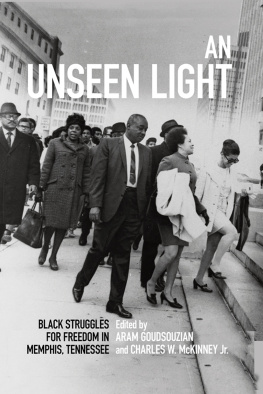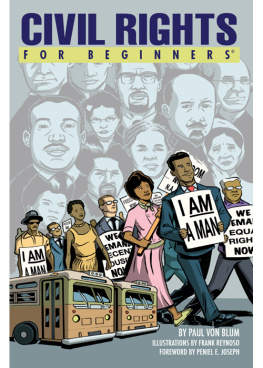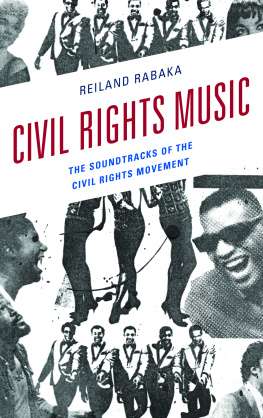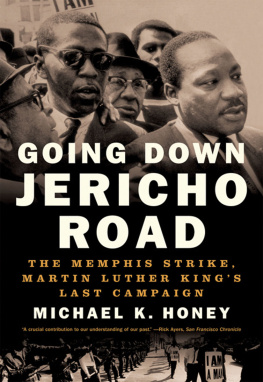
An Unseen Light
An Unseen Light
Black Struggles for Freedom in Memphis, Tennessee
Edited by
Aram Goudsouzian
and
Charles W. McKinney Jr.

Due to variations in the technical specifications of different electronic reading devices, some elements of this ebook may not appear as they do in the print edition. Readers are encouraged to experiment with user settings for optimum results.
Copyright 2018 by The University Press of Kentucky
Scholarly publisher for the Commonwealth,
serving Bellarmine University, Berea College, Centre College of Kentucky, Eastern Kentucky University, The Filson Historical Society, Georgetown College, Kentucky Historical Society, Kentucky State University, Morehead State University, Murray State University, Northern Kentucky University, Transylvania University, University of Kentucky, University of Louisville, and Western Kentucky University.
All rights reserved.
Editorial and Sales Offices: The University Press of Kentucky
663 South Limestone Street, Lexington, Kentucky 40508-4008
www.kentuckypress.com
Library of Congress Cataloging-in-Publication Data
Names: Goudsouzian, Aram, editor. | McKinney, Charles Wesley, 1967- editor.
Title: An unseen light : black struggles for freedom in Memphis, Tennessee / edited by Aram Goudsouzian and Charles W. McKinney Jr.
Other titles: Civil rights and the struggle for Black equality in the twentieth century.
Description: Lexington, Kentucky : The University Press of Kentucky, [2018] | Series: Civil rights and the struggle for Black equality in the twentieth century | Includes bibliographical references and index.
Identifiers: LCCN 2017058296| ISBN 9780813175515 (hardcover : alk. paper) | ISBN 9780813175539 (pdf) | ISBN 9780813175522 (epub)
Subjects: LCSH: African AmericansCivil rightsTennesseeMemphisHistory. | African AmericansPolitical activityTennesseeMemphisHistory. | African AmericansTennesseeMemphisHistory. | Memphis (Tenn.)Race relationsHistory. | Civil rights movementsTennesseeMemphisHistory. | Memphis (Tenn.)Politics and government.
Classification: LCC F444.M59 N489 2018 | DDC 323.1196/073076819dc23
LC record available at https://lccn.loc.gov/2017058296
This book is printed on acid-free paper meeting the requirements of the American National Standard for Permanence in Paper for Printed Library Materials.

Manufactured in the United States of America.
Member of the Association of University Presses
Contents
Aram Goudsouzian and Charles W. McKinney Jr.
Brian D. Page
Darius Young
Elton H. Weaver III
David Welky
Beverly Greene Bond
Jason Jordan
Laurie B. Green
Elizabeth Gritter
Steven A. Knowlton
Charles L. Hughes
Aram Goudsouzian
Anthony C. Siracusa
James Conway
Shirletta Kinchen
Zandria F. Robinson
Michael K. Honey
Charles W. McKinney Jr.
Introduction
Aram Goudsouzian and Charles W. McKinney Jr.
Richard Wright was walking down Beale Street in a tattered overcoat, lugging a cardboard suitcase. It was a cold, gusty Sunday morning in November. He was seventeen years old, a migrant from Mississippi. Leery of sordid tales about Memphis, he had strapped all his cash to his body, even if all that sin was just a scent in the air, a remnant of Saturday night carousing.1
Beale Street was famous for its con men and crap games, its saloons and scamps, its pickpockets and prostitutes. It was also the place where W. C. Handy wrote Memphis Blues and St. Louis Blues, launching a new American musical tradition. It was the place where Robert Church Sr. laid the foundation for his economic empire, becoming the nations first black millionaire, and where Robert Church Jr. built a political machine, leveraging black votes for influence with the citys boss, E. H. Crump. It was the place where Ida B. Wells published her crusading newspaper Memphis Free Speech, and where a mob deposited the severed head of a black lynching victim named Ell Persons. Beale Street condensed the entire African American experience into a few blocks of bars, bordellos, shops, and offices.2
Wright had lived in Memphis once before, arriving with his family in 1911, when he was just three. In his memoir Black Boy, he described this initial stint as a baptism in depravity. He wrote of murdering a kitten, of fighting for his grocery money against a band of tough boys, of entertaining saloon crowds by getting drunk. His father, a victim of Beale Streets temptations, abandoned the family. His mother, unable to feed her kids, sent them to an orphanage. When he was eight or nine, she gathered them again and headed for Elaine, Arkansas, another stop along the lower Mississippi River, part of a long wandering loop in search of a better life.3
When Wright returned in 1925, Memphis was a center of southern industry, with about 160,000 residents, one-third of whom were black. The citys downtown boasted the new twelve-story Peabody Hotel and impressive edifices such as Lowensteins Department Store, the Cotton Exchange Building, and the Union Planter Bank Building. If Memphis had a reputation as the murder capital of America, it was also a land of opportunity, drawing migrants from the rural plantations of the Mississippi Delta. Wright soon found respectable lodgings and a decent job at an optical company.4
For Wright, though, Memphis was a cruel riddle. Jim Crow asked terrible questions that had no good answers. Surviving the South meant hiding behind a mask. White people could never know your frustrations, your fears, your aspirations, or your intelligence. At the optical company, the white men told Wright that another young man wanted to kill him, and they told the other worker the same thingthey just wanted to see two black boys fight. That racism, and the corresponding poverty, poisoned his fellow blacks. The elevator operator at the company, an otherwise smart and proud man named Shorty, would shuck, jive, and let white people kick him in the rump for a quarter, rationalizing that my ass is tough and quarters is scarce.5
Reading was Wrights salvation, his gateway to a wider world. One day he read an editorial in the Commercial Appeal that chastised H. L. Mencken. He grew curious. Who was this prickly social critic, and how had he inflamed these white southerners? Satisfying his curiosity meant wearing another mask. To be allowed to check out books from the Memphis Public Library, Wright forged a note from a white man: Dear Madam: Will you please let this nigger boy have some books by H. L. Mencken?
He had to leave the South. If he accepted his inferior station, he would hate himself. If he succumbed to booze and sex, he would be just like his father. If he turned into an angry revolutionary, the racists would kill him. He read Mencken and then Theodore Dreiser and Sherwood Anderson and Sinclair Lewis, and although they described essentially alien worlds, these writers seemed to feel that America could be shaped nearer to the hearts of those who lived in it. And so in 1927 Richard Wright boarded a train for Chicago. Those novels and essays had served as an inspiration, like a tinge of warmth from an unseen light.6
But Wright could not see the lights that shone in Memphis. His zeal to migrate north blinded him to the various ways African Americans had shaped the politics and culture of this city at the crossroads, sitting atop a Mississippi River bluff, with the fertile and oppressive Delta fanning to its south. Black Memphians found salvation and independence in churches. They did the courageous and calculated work of political organizing. They made music that became a seminal American art form with global impact. And they forged a brilliant, complicated, dynamic movement for freedom. Wright could see only the shadow that racial oppression cast over this variegated history; he could not see the ways in which black people survived, accommodated, subverted, battled, and wrestled with the persistence of racial subordination. Throughout these struggles, black Memphians forged stories as individuals and as a people.
Next page










